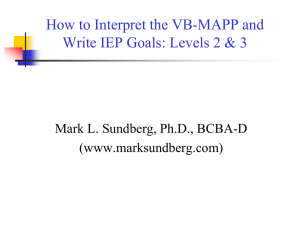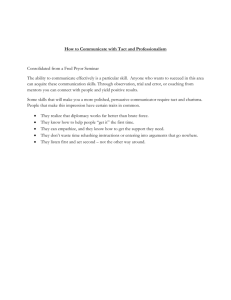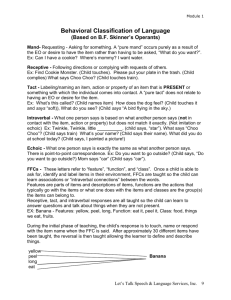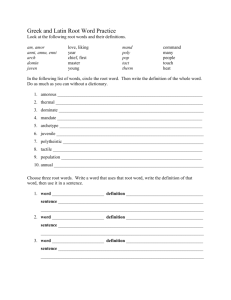Language Assessment and Intervention for Children with Autism
advertisement
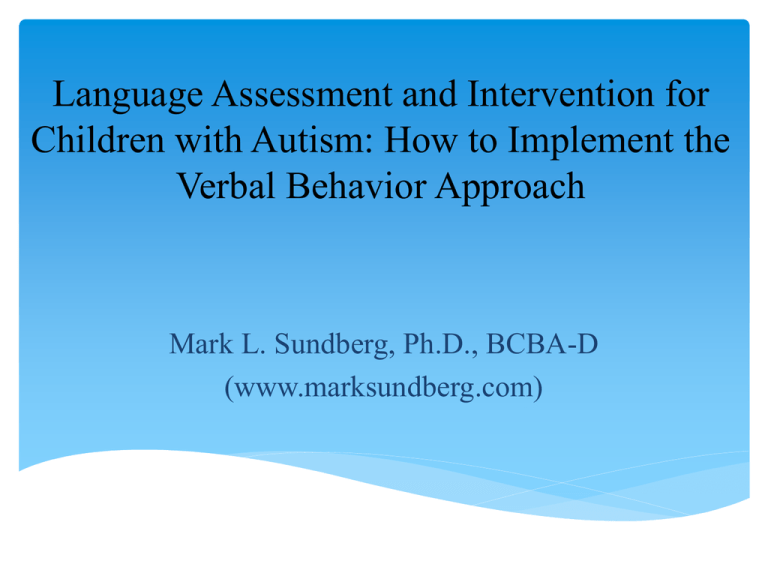
Language Assessment and Intervention for Children with Autism: How to Implement the Verbal Behavior Approach Mark L. Sundberg, Ph.D., BCBA-D (www.marksundberg.com) The Importance of Assessment • • • • • Assessment (analysis) drives the intervention An initial assessment provides a baseline (operant skill level) On-going assessment provides tracking and outcome data On-going assessment can guide program adjustments The failure to conduct an adequate assessment can result in an inappropriate and ineffective curriculum for a child, as well as a waste of valuable teaching time and resources What Should be Assessed for Children with Autism? • It is essential to identify a child’s existing verbal, nonverbal, and social skills (e.g., mands, echoics, listener skills, peer initiation) • It is also essential to identify the language, social, behavioral, and learning barriers that are preventing or slowing down skill acquisition • Most common language assessment tools for children with autism fail to provide this necessary information (Esch, LaLonde, & Esch, 2010) • For example, 28 out of 30 assessments fail to assess a child’s mand repertoire (Esch et al, 2010), and none provide an assessment of possible barriers The Value of a Criterion-Referenced Assessment • Norm-referenced vs. criterion-referenced • A norm-referenced tests ranks and sorts students using percentile measures relative to a large sample of peers (e.g., IQ tests, SAT, PPVT, “Bell curve”) • A criterion-referenced test provides a measure of a student’s mastery of a pre-determined group of skills (e.g., math skills) • A criterion-referenced test provides specific information as to what a student (or professional) can or cannot do in a certain domain (e.g., manding, national board medical exam, BACB exam) • A criterion-referenced assessment provides the operant level (baseline) of a domain of skills for an individual learner, and can directly point to intervention needs and priorities A Behavioral Approach to Assessment for Children with Autism • Basic behavioral concepts and principles allow professionals to identify and quantify learning, as well as barriers (e.g., motivation, reinforcement, stimulus control, generalization) • A behavioral analysis of typical human development provides a frame of reference for an assessment (e.g., Bijou & Baer, 1965; Novak & Pelaez, 2003; Schlinger, 1996; Skinner, 1957) • Skinner’s (1957) analysis of verbal behavior provides a behavioral framework of language and social behavior that can be used to guide an assessment and intervention program (Sundberg & Michael, 2001) The Value of Skinner’s Analysis of Language • Expands and clearly delineates the traditional categories of expressive (speaker) and receptive (listener) language • “Expressive language” is expanded across the verbal operants • • • • • • echoic (motor imitation, copying-a-text) mand tact intraverbal textual transcriptive • “Receptive language” is expanded to four distinct repertoires • • • • listener discriminations (receptive language) audience participation mediator of reinforcement emotional responder Verbal Behavior Milestones Assessment and Placement Program: The VB-MAPP • There are five components of the VB-MAPP • The VB-MAPP: Milestones Assessment measures 16 domains with 170 language, learning, and social milestones, across 3 developmental levels (0-18 months, 18-30 months, 30-48 months) • The VB MAPP: Barriers Assessment examines 24 common learning and language barriers often faced by children with autism • The VB MAPP: Transition Assessment is a summary assessment of 18 domains and can serve as a guide for planning a child’s educational needs Verbal Behavior Milestones Assessment and Placement Program: The VB-MAPP • The VB-MAPP: Supporting Skills and Task Analysis provides a checklist of hundreds of additional skills that may not warrant milestone status, but support the development of each of the domains (e.g., mands for attention, tacts of auditory stimuli) • In addition, this section contains a task analysis of the 170 milestones, which is valuable for those progressing at a slower rate • The VB-MAPP: Placement and IEP Goals provides recommendations for program development based on the child’s VB-MAPP profile, and his specific scores on the 170 milestones and the 24 Barriers • Also contains a bank of over 200 IEP objectives directly linked to the milestones and barriers assessments The VB-MAPP Milestones: How to Score the Assessment • • • • • • • • • • 16 domains are presented in three developmental levels: The elementary verbal operants (echoic, mand, tact, intraverbal, etc.) The listener skills Vocal output Independent play Social skills and social play Visual perceptual skills and matching-to-sample Grammatical and syntactical skills Group and classroom skills Beginning academic skills 30-48 months Typical development There are 3 developmental levels 18-30 months Typical development 0-18 months Typical development Level 3 measures 13 domains with 65 milestones First 6 domains appear in all three levels Level 2 measures 12 domains with 60 milestones Level 1 measures 9 domains with 45 milestones Reading, writing, and math are added in level 3 LRFFC, IV, group, and linguistic measures are added in levels 2 and 3 Motor imitation and echoic appear only in levels 1 and 2 Vocal play (babbling) is dropped in levels 2 and 3 Sophie A. 7/1/11 3 yrs. 7/23/14 MS Enter tester(s) Enter the child’s personal information How to score the cells: Mand Level 1 Enter date Enter color 1 5 Milestones for each Domain, at each level Enter a score of 1, ½, or 0, based on the scoring criteria in the VB-MAPP Guide Designed for 4 testing periods, but more can be added 4 ways to obtain the relevant data 1 41/2 Enter the total score here 1 1 1 1/2 Add any relevant information such as specific words, or oddities such as all 10 mands are for different toy dinosaurs The scoring instructions and criteria are contained in the VB-MAPP Guide, but are easily accessible in the app and web-based versions 5 items for each milestone VB-MAPP Master Scoring Form Key: Child's name: William Date of birth: Age at testing: 1st test: 4/12/11 1 2nd test: 2 3 4 Score Date 1 7/23/14 Color Tester MS 3rd test: 4th test: LEVEL 3 Mand Tact Listener VP/MTS Play Social Mand Tact Listener VP/MTS Play Social Mand Tact Listener VP/MTS Play Social Reading Writing LRFFC IV Group Ling. Echoic LRFFC IV Group Ling. Echoic Vocal 15 14 13 12 11 LEVEL 2 Imitation 10 9 8 7 6 LEVEL 1 5 4 Fill in the corresponding cells with the scores obtained 3 2 1 Copyright 2008 Mark L. Sundberg Imitation Math Enter the total score here VB-MAPP Master Scoring Form Key: Child's name: William Date of birth: Age at testing: 4/12/11 1 Score 1st test: Date Color 7/23/14 Tester MS 2nd test: 2 3 4 3rd test: 4th test: LEVEL 3 Mand Tact Listener VP/MTS Play Social Reading Writing LRFFC IV Group Ling. Math 15 14 13 12 Skills can be tested one at a time, or all together 11 LEVEL 2 Mand Tact Listener VP/MTS Play Social Imitation Echoic LRFFC IV Group Ling. Repeat the trial if necessary 10 9 8 7 There is no time limit 6 LEVEL 1 Mand Tact Listener VP/MTS Play Social Imitation Echoic Vocal 5 4 Multiple assessors can participate 3 2 1 Copyright 2008 Mark L. Sundberg Reinforce correct responses VB-MAPP Master Scoring Form Key: Child's name: Isander Date of birth: 11/09/2006 Age at testing: 1 2-11 1st test: Score Date 27 10/28/09 Color Tester J. Simmons 2nd test: 2 3 4 3rd test: 4th test: LEVEL 3 Mand Tact Listener VP/MTS Play Social Mand Tact Listener VP/MTS Play Social Reading Writing LRFFC IV Group Ling. Echoic LRFFC IV Group Ling. Math 15 14 13 12 11 LEVEL 2 Fill in the oval for a domain that was tested, but a “0” score was given Imitation 10 9 1/2 point scores look like this 8 7 6 LEVEL 1 Mand 5 4 3 2 1 Tact Listener VP/MTS Play Social Imitation Echoic Vocal Some milestones might get “0” while higher milestones are met VB-MAPP Master Scoring Form Key: Child's name: Isander Date of birth: 11/09/2006 Age at testing: 1 2-11 1st test: Score Date 27 10/28/09 Color Tester J. Simmons 2nd test: 2 3 4 3rd test: 4th test: LEVEL 3 3 things to look for in a VB-MAPP profile Mand Tact Listener VP/MTS Play Social Mand Tact Listener VP/MTS Play Social Reading Writing LRFFC IV Group Ling. Echoic LRFFC IV Group Ling. Math 15 14 13 12 11 LEVEL 2 Imitation 10 9 (3) Are there stronger skills that can be used to teach weaker skills? 8 7 6 LEVEL 1 (2) Are the skills fairly in balance with each other? Mand Tact Listener VP/MTS Play Social Imitation Echoic Vocal 5 4 3 2 1 (1) Primary level There are 5 levels and 100 possible points The sounds are developmentally sequenced The first three levels differ by the number of syllables The last two involve prosody and other measures Score the response as X, /, or blank Enter the scores here 11/2 X / Enter the total score here Convert the scores on the corresponding milestone form 1/2 Enter the total score here 1/2 0 The specific instructions are in the VBMAPP Guide 0 0 0 11/2 Enter the raw score here, as well as any comments VB-MAPP Master Scoring Form Key: Child's name: William Date of birth: Age at testing: 4/12/11 1 Score 1st test: Date Color 7/23/14 Tester MS 2nd test: 2 3 4 3rd test: 4th test: LEVEL 3 Mand Tact Listener VP/MTS Play Social Mand Tact Listener VP/MTS Play Social Mand Tact Listener VP/MTS Play Social Reading Writing LRFFC IV Group Ling. Echoic LRFFC IV Group Ling. Echoic Vocal Math 15 14 13 12 11 LEVEL 2 Imitation 10 9 8 7 6 LEVEL 1 Imitation 5 4 3 2 1 Copyright 2008 Mark L. Sundberg Fill in the cell The VB-MAPP Barriers Assessment • It is important to find out what a child can do (The VB-MAPP Milestones Assessment), but also important to be aware of the problems and challenges he or she faces • The VB-MAPP Barriers Assessment is designed to identify and score 24 different learning and language acquisition barriers • Many of these barriers are identified in the DSM-5 (inflexible routines, repetitive behaviors, deficits in social communication, sensory defensiveness, fixated interests) • Once a specific barrier has been identified, a more detailed descriptive and/or functional analysis of that problem is required • An individualized functional or descriptive analysis will be necessary to determine the nature of the problem, and what intervention program might be appropriate for the child The VB-MAPP Barriers Assessment • There are several different types of barriers that can affect learning and language development • Strong and persistent negative behaviors that impede teaching and learning (e.g., non-compliance, tantrums, aggression, SIB) • Verbal operants or related skills that are absent, weak, or in some way impaired (e.g., echolalia, rote intraverbals, “mands” that are really tacts) • Social behavior and the speaker-listener dyad can also become impaired for a variety of reasons (e.g., limited motivation for social interaction, impaired mands, impaired listener skills) The VB-MAPP Barriers Assessment • Fundamental barriers to learning that must be analyzed and ameliorated (e.g., the failure to generalize, weak motivators, prompt dependency) • Specific behaviors that can compete with teaching (e.g., selfstimulation, hyperactive behavior, or sensory defensiveness) • Problems related to physical, medical, or biological barriers that must be accounted for in some way (e.g., articulation or motor imitation errors may be due to physical limitations, matching errors may be due to visual limitations, listener errors may be related to hearing problems, poor performance may be due to illness, sleep deprivation, severe allergies, medication changes, pain, etc.) The VB-MAPP Barriers Assessment • 24 Common Learning and Language Acquisition Barriers • • • • • • • • Behavior problems Instructional control (escape/avoidance) Impaired mand Impaired tact Impaired motor imitation Impaired echoic (e.g., echolalia) Impaired matching-to-sample Impaired listener repertoires (e.g., LD, LRFFC) The VB-MAPP Barriers Assessment • Common Learning and Language Acquisition Barriers • • • • • • • • Impaired intraverbal Impaired social skills Prompt dependency, long latencies Scrolling responses Impaired scanning skills Failure to make conditional discriminations (CDs) Failure to generalize Weak or atypical MOs The VB-MAPP Barriers Assessment • Common Learning and Language Acquisition Barriers • • • • • • • • Response requirements weakens the MO Reinforcer dependent Self-stimulation Articulation problems Obsessive-compulsive behavior Hyperactivity Failure to make eye contact Sensory defensiveness Enter the child’s personal and other information here Enter a score using a 1-4 likert scale Leave the barrier blank for a score of “0” (no barrier) . Sophie A 7/1/11 3 yrs 7/23/14 MS General criteria for scoring each of the 24 Barriers can be found on pages 25-29 in the Protocol 3 More detailed instructions can be found in the VBMAPP Guide, Chapter 6 Enter the score here . Sophie A 7/1/11 3 yrs Enter the score in the barriers form 7/23/14 MS VB-MAPP Language Barriers Scoring Form Key: Score Child's name: Jacob 1st test: 26 Date of birth: 1/8/2009 2nd test: Age at testing: 1 3 2 3 4 Date Color Tester MS 3rd test: 4th test: Behavior Problems Impaired Mand Instructional Control Impaired Tact Impaired Echoic Impaired Imitation 4 3 2 1 1 2 3 4 1 2 3 4 Impaired Listener Impaired VP-MTS 1 2 3 4 Impaired Intraverbal 1 2 3 4 1 Impaired Social Skills 2 3 4 1 Prompt Dependent 2 3 4 Scrolling 4 Many of the barriers can be detected while conducting the milestones assessment (e.g., non-compliance, scrolling) 3 2 1 1 2 3 4 Impaired Scanning 1 2 3 4 Impaired Conditional Discrimination 1 2 3 4 1 2 3 4 1 3 4 Response Requirement Weakens MO Weak Motivators Failure to Generalize 2 1 2 3 4 Reinforcer Dependent 4 3 2 1 1 2 Self- 3 4 Stimulation 1 2 3 4 Impaired Articulation 1 2 3 4 ObsessiveCompulsive Behavior 1 2 3 4 Hyperactive Behavior 1 2 3 4 Failure to Make Eye Contact 1 2 3 4 Sensory Defensiveness 4 3 2 1 1 2 3 4 1 2 3 4 1 2 3 4 1 2 3 4 1 2 3 4 1 2 3 4 Enter the total score here VB-MAPP Master Scoring Form Key: Child's name: Derek 1st test: Date of birth: Age at testing: Score Date Color 37 Tester AM 2nd test: 1 4. 6 2 4 3rd test: 4th test: LEVEL 3 Mand Tact Listener VP/MTS Play Social Mand Tact Listener VP/MTS Play Social Mand Tact Listener VP/MTS Play Social Reading Writing LRFFC IV Group Ling. Echoic LRFFC IV Group Ling. Echoic Vocal 15 14 13 12 11 LEVEL 2 Imitation 10 9 8 7 6 LEVEL 1 5 4 3 2 1 Copyright 2007-2008 Mark L. Sundberg Imitation Math VB-MAPP Language Barriers Scoring Form Key: Score Date Child's name: Derek 1st test: 29 7/3/07 Date of birth: 1-23-03 2nd test: 1 Age at testing: 4.6 2 3 4 Color Tester SM 3rd test: 4th test: Behavior Problems Impaired Mand Instructional Control Impaired Tact Impaired Impaired Imitation Echoic 4 3 2 1 1 2 3 4 1 2 3 4 Impaired Listener Impaired VP-MTS 1 2 3 4 Impaired Intraverbal 1 2 3 4 1 Impaired Social Skills 2 3 4 1 Prompt Dependent 2 3 4 Scrolling 4 3 2 1 1 2 3 4 Impaired Scanning 1 2 3 4 Impaired Conditional Discrimination 1 2 3 4 1 2 3 4 1 3 4 1 Response Requirement Weakens MO Weak Motivators Failure to Generalize 2 2 3 4 Reinforcer Dependent 4 3 2 1 1 2 Self- 3 4 Stimulation 1 2 3 4 Impaired Articulation 1 2 3 4 ObsessiveCompulsive Behavior 1 2 3 4 Hyperactive Behavior 1 2 3 4 1 Failure to Make Eye Contact 2 3 4 Sensory Defensiveness 4 3 2 1 1 2 3 4 1 2 3 4 1 2 3 4 1 2 3 4 1 2 3 4 1 2 3 4 VB-MAPP Master Scoring Form Key: Child's name: Derek 1st test: Date of birth: 1-23-03 2nd test: Age at testing: 1 4. 6 2 4 5 Score 37 Date Color Tester 7/21/07 SM 64.5 1/11/08 SM 3rd test: 4th test: LEVEL 3 Mand Tact Listener VP/MTS Play Social Mand Tact Listener VP/MTS Play Social Mand Tact Listener VP/MTS Play Social Reading Writing LRFFC IV Group Ling. Echoic LRFFC IV Group Ling. Echoic Vocal 15 14 13 12 11 LEVEL 2 Imitation 10 9 8 7 6 LEVEL 1 5 4 3 2 1 Copyright 2007-2008 Mark L. Sundberg Imitation Math VB-MAPP Language Barriers Scoring Form Key: Score Date Child's name: Derek 1st test: 29 7/3/07 SM Date of birth: 1-23-03 2nd test: 9 1/11/08 SM 1 Age at testing: 4.6 2 3 5 4 Color Tester 3rd test: 4th test: Behavior Problems Impaired Mand Instructional Control Impaired Tact Impaired Imitation Impaired Echoic 4 3 2 1 1 2 3 4 1 2 3 4 Impaired Listener Impaired VP-MTS 1 2 3 4 Impaired Intraverbal 1 2 3 4 1 Impaired Social Skills 2 3 4 1 Prompt Dependent 2 3 4 Scrolling 4 3 2 1 1 2 3 4 Impaired Scanning 1 2 3 4 Impaired Conditional Discrimination 1 2 3 4 1 2 3 4 1 3 4 1 Response Requirement Weakens MO Weak Motivators Failure to Generalize 2 2 3 4 Reinforcer Dependent 4 3 2 1 1 2 3 4 Self-Stimulation 1 2 3 4 Impaired Articulation 1 2 3 4 ObsessiveCompulsive Behavior 1 2 3 4 Hyperactive Behavior 1 2 3 4 1 Failure to Make Eye Contact 2 3 4 Sensory Defensiveness 4 3 2 1 1 2 3 4 1 2 3 4 1 2 3 4 1 2 3 4 1 2 3 4 1 2 3 4 The VB-MAPP Transition Assessment • A common goal for many educators and parents of children with special needs is to integrate the child into a mainstream setting • There are many different levels of integration and the Transition Assessment was designed to identify the skills that increase the probability that a child will be successful in a less restrictive setting • No single skill will be a good determiner of success, but a collective body of skills can help educators and parents make decisions • The VB-MAPP Transition Assessment provides a tool to help determine if a child has the necessary prerequisite skills to learn in a less restrictive classroom environment • There are 18 skill areas on the Transition Assessment Enter the child’s personal and other information here Enter a score using a 1-5 likert scale . Sophie A 7/1/11 3 yrs 7/23/14 MS General criteria for scoring each of the 18 transition items can be found on pages 31-34 in the Protocol 3 More detailed instructions can be found in the VBMAPP Guide, Chapter 7 Enter the score here . Sophie A 7/1/11 3 yrs Enter the score in the transition form 7/23/14 MS VB-MAPP Transition Scoring Form Key: Score Date Child's name: Ann 1st test: 33 4/17/09 SM Date of birth: 3/22/2005 2nd test: 65 5/21/10 SM 1 Age at testing: 4 2 3 5 4 Color Tester 3rd test: 4th test: VB-MAPP Milestones Score VB-MAPP Barriers Score Negative Behaviors and Instructional Control Classroom Routines and Group Skills Social Skills and Social Play Independent Academic Work Enter the total score here 5 4 3 2 1 1 2 3 4 1 2 3 4 1 Range of Reinforcers Generalization 2 3 4 1 Rate of Skill Acquisition 2 3 4 1 Retention of New Skills 2 3 4 1 Natural Environment Learning 2 3 4 Transfer Without Training 5 4 3 2 1 1 2 3 4 1 Adaptability to Change 2 3 4 1 2 3 4 1 Self-Directed Leisure Time Spontaneous Behaviors 2 3 4 1 General Self-Help 2 3 4 1 Toileting Skills 2 3 4 Eating Skills 5 4 3 2 1 1 2 3 4 1 2 3 4 1 2 3 4 1 2 3 4 1 2 3 4 1 2 3 4 This section contains over 300 tasks leading up to milestones, and over 500 additional “supporting skills” that are not directly related to a milestone but are developmentally framed by the milestones More detailed instructions can be found in the VB-MAPP Guide, Chapter 2 X Enter a check mark here when the skill is met score here Skills 6-a, 6-c, & 6-d are supporting skills; and skill 6-b is part of the milestones task analysis Enter the score on the task analysis and skills tracking form VB-MAPP Task Analysis Skills Tracking Chart: Level 2 (18-30 months) Child's name: Date of birth: Age at testing: Sophie A. 7/1/10 4 yrs 1 2 3 Key: 1st test: 2nd test: 3rd test: 4th test: 4 Score Date 7/23/14 Color Tester MS Mand Tact Listener VP_MTS Play Social Imitation Echoic LRFFC IV Group Linguistics 10-M 10-f 10-e 10-d 10-c 10-b 10-a 10-M 10-e 10-d 10-c 10-b 10-a 10-M 10-e 10-d 10-c 10-b 10-a 10-M 10-e 10-d 10-c 10-b 10-a 10-M 10-f 10-e 10-d 10-c 10-b 10-a 10-M 10-e 10-d 10-c 10-b 10-a 10-M 10-e 10-d 10-c 10-b 10-a 10-M 10-M 10-g 10-f 10-e 10-d 10-c 10-b 10-a 10-M 10-g 10-f 10-e 10-d 10-c 10-b 10-a 10-M 10-g 10-f 10-e 10-d 10-c 10-b 10-a 10-M 10-d 10-c 10-b 10-a 9-M 9-f 9-e 9-d 9-c 9-b 9-a 9-M 9-e 9-d 9-c 9-b 9-a 9-M 9-d 9-c 9-b 9-a 9-M 9-e 9-d 9-c 9-b 9-a 9-M 9-d 9-c 9-b 9-a 9-M 9-f 9-e 9-d 9-c 9-b 9-a 9-M 9-d 9-c 9-b 9-a 9-M 9-M 9-g 9-f 9-e 9-d 9-c 9-b 9-a 9-M 9-f 9-e 9-d 9-c 9-b 9-a 9-M 9-d 9-c 9-b 9-a 9-M 9-e 9-d 9-c 9-b 9-a 8-M 8-f 8-e 8-d 8-c 8-b 8-a 8-M 8-d 8-c 8-b 8-a 8-M 8-d 8-c 8-b 8-a 8-M 8-e 8-d 8-c 8-b 8-a 8-M 8-d 8-c 8-b 8-a 8-M 8-d 8-c 8-b 8-a 8-M 8-g 8-f 8-e 8-d 8-c 8-b 8-a 8-M 8-M 8-e 8-d 8-c 8-b 8-a 8-M 8-d 8-c 8-b 8-a 8-M 8-d 8-c 8-b 8-a 8-M 8-d 8-c 8-b 8-a 7-M 7-g 7-f 7-e 7-d 7-c 7-b 7-a 7-M 7-e 7-d 7-c 7-b 7-a 7-M 7-d 7-c 7-b 7-a 7-M 7-f 7-e 7-d 7-c 7-b 7-a 7-M 7-e 7-d 7-c 7-b 7-a 7-M 7-d 7-c 7-b 7-a 7-M 7-g 7-f 7-e 7-d 7-c 7-b 7-a 7-M 7-M 7-c 7-b 7-a 7-M 7-d 7-c 7-b 7-a 7-M 7-e 7-d 7-c 7-b 7-a 7-M 7-c 7-b 7-a 6-M 6-e 6-d 6-c 6-b 6-a 6-M 6-d 6-c 6-b 6-a 6-M 6-d 6-c 6-b 6-a 6-M 6-h 6-g 6-f 6-e 6-d 6-c 6-b 6-a 6-M 6-e 6-d 6-c 6-b 6-a 6-M 6-e 6-d 6-c 6-b 6-a 6-M 6-e 6-d 6-c 6-b 6-a 6-M 6-M 6-M 6-d 6-c 6-b 6-a 6-M 6-d 6-c 6-b 6-a 6-M The VB-MAPP Placement and IEP Goals • The placement section (VB-MAPP Guide, chapters 8-10) contains an interpretation and suggestions for programming for all 170 milestones • It also contains over 200 template IEP goals covering all 170 milestones Contains an analysis of the skill and how it interfaces with other domains If a child has met this milestone, what’s next? Suggests programming direction Issues to consider in establishing the skill Where to start More cautions: potential barrier development A bank of possible IEP goals are provided for each group of 5 milestones All 200 IEP goals can be downloaded in one Word file at www.avbpress.com/downloads VB-MAPP Master Scoring Form Key: Child's name: Garrett 1st test: Date of birth: Age at testing: Score Date Color Tester 17 2nd test: 1 41/2 2 3 4 3rd test: 4th test: LEVEL 3 Mand Tact Listener VP/MTS Play Social Mand Tact Listener VP/MTS Play Social Mand Tact Listener VP/MTS Play Social Reading Writing LRFFC IV Group Ling. Echoic LRFFC IV Group Ling. Echoic Vocal 15 14 13 12 11 LEVEL 2 Imitation 10 9 8 7 6 LEVEL 1 5 4 3 2 1 Copyright 2007-2008 Mark L. Sundberg Imitation Math VB-MAPP Master Scoring Form Key: Child's name: Justin 1st test: Date of birth: Age at testing: Score Date Color Tester 68.5 2nd test: 16 2 3 4 3rd test: 4th test: LEVEL 3 Mand Tact Listener VP/MTS Play Social Mand Tact Listener VP/MTS Play Social Mand Tact Listener VP/MTS Play Social Reading Writing LRFFC IV Group Ling. Echoic LRFFC IV Group Ling. Echoic Vocal 15 14 13 12 11 LEVEL 2 Imitation 10 9 8 7 6 LEVEL 1 5 4 3 2 1 Copyright 2007-2008 Mark L. Sundberg Imitation Math Conclusions • Behavior analysis has much to offer autism assessment and treatment • Skinner’s analysis of verbal behavior is a powerful tool • Assessment is essential for an effective and efficient intervention program • The VB-MAPP can provide important direction for any style of intervention program Conclusions • Skinner (1978) stated • “Verbal Behavior…will, I believe, prove to be my most important work” (p. 122) • Language and social communication are the most important, but most complicated aspect of human behavior • Language and social communication are the primary handicapping condition of autism
